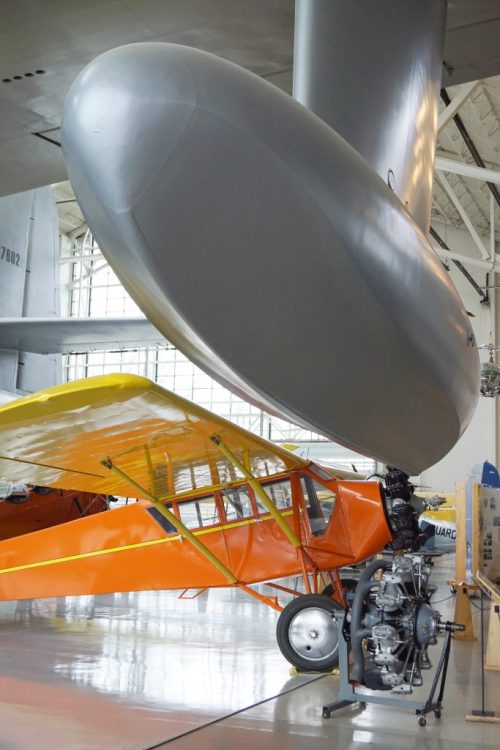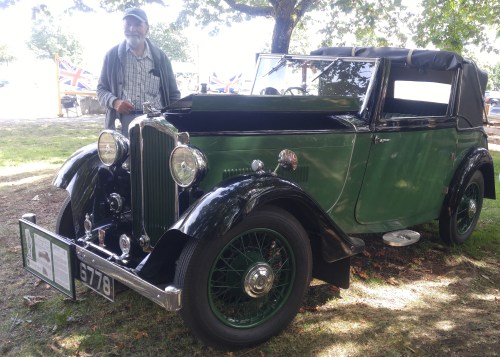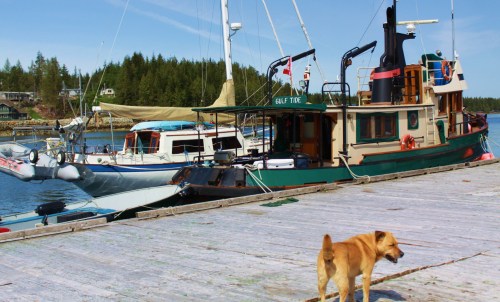It is a real place and home of a very fine aviation exhibition, The Evergreen Aviation Museum. I arrived too late to go in for a self-guided tour. I would need at least a half day. They let me park in the back corner, dry-camping next to old US Air Force rockets. There are four massive buildings. The largest one houses the Hughes Hercules and is nearly big enough to fly some of the small aircraft I have known, around inside it! The massive airplane is known worldwide as the “Spruce Goose” although it is actually built almost entirely of birch plywood. Howie himself flew it, once. An icon of dreams, it is the world’s largest wooden airplane ever and among the world’s largest airplanes, even today. Of all the amazing achievements of old weird Howard, this is the big one. Just imagine all the people telling him and his crew that it couldn’t be done. But he did, and so did it. Then WW II ended and the need for a massive air transport machine ended, at least for the time being.











When it hit the civilian market in the 1930’s it was faster than anything the US military possessed at that time.

One of my flying mentors built one of these during the Great Depression and made an income selling rides. As he travelled, he’d sleep beneath a wing at night. There should be a song: “And that’s why I hit the tree, I couldn’t see, there was a radiator right in front of me.” These are still being built today with modern engines.









Even as modern airplanes go, the Goose thing is a monster. I am amazed at the survival of this wooden wonder. How it has not rotted or burned in 75 years is yet another wonder. The aircraft that I came to see is the only one of its kind ever built. This is my Mecca, the object of a pilgrimage for a guy who has been flying and otherwise messing around with airplanes his whole life. I’m hoping to find inspiration to cope with some tough weeks ahead. I’ve looked up at it already. The only time I’ve know that same feeling before was when I stepped aboard ‘Cutty Sark’ in Greenwich.
The museum itself is massive with its four huge (Ha… Hughes, get it?) buildings, three are for display and a third is a swimming pool. They have somehow hoisted a Boeing 747 (Imagine the fleet of monster cranes required to work in full co-ordination…with no wind)) onto the roof and converted it into the apex of a water slide. The parking lot behind the buildings would be adequate for landing smaller aircraft.. Imagine having rows of jet fighters for lawn ornaments!

It sure beats plastic flamingos or garden gnomes. It is a Lockheed T-33 or ‘Shooting Star’ I remember then from my early childhood. they are still flying in a few countries.






The exhibits go on and on, with a movie theatre complex in the middle of the complex. I am a small airplane guy and there were plenty of these dispersed among the big fellows, both civilian and military. It was a dull overcast day for taking photographs, but I managed to click off about one-hundred-fifty frames that I’m keeping. That is a lot of editing. I could have easily taken twice as many.
Evergreen, a private enterprise, draws a very close second to the amazing Boeing aircraft museum in Seattle which doesn’t have a water park. Ha! It also doesn’t have the Goose or, the SR71 Blackbird. There are also two other great aviation museums in the state of Oregon, one in Tillamook and another in Madras. Here are a few of the photos taken at Evergreen, I once again repeat myself in saying that they don’t begin to compare with actually seeing this operation in the flesh. When I was growing up in the post-war, pre-space age, aviation was still a bit of a novelty. That, despite the massive aviation advancements of WWII. By the time we had put men on the moon the reality of flying machines had become a ho-hum fact of everyday life. We no longer look up when an aircraft passes overhead. Yet, clearly, there are a great many people who do hold a deep fascination for a highly and still rapidly evolving technology which is only a little over a century old.
I have long held the theory that the human race is not indigenous to this planet. We certainly do not fit in here. As far back as we know, we have had an affinity for the sky, for the stars, for flight. God is always from somewhere up there ( God being the concept which is our convenient pigeon-hole for all that we cannot comprehend including love, wisdom and infinity) Many of our wisest ancients speculated on ways and means to rise above our earthly bonds. We have scrambled frantically to fly, then to fly ever higher and faster. It is a compulsion which now has us sending machines beyond the known edges of our universe, looking for ways to personally visit and inhabit places like Mars. I believe that it is all part of that ancient quest to find our way home. Yet at the same time, we need to look within and consider our aberrant nature, and that that is perhaps why our ancient ancestors were dropped off here. Once we realize the way to get along with each other, as well as other species, only then will we be truly ready to go home. Then we won’t need to. In the meantime, to survive that long, we need to become considerably more gracious toward the beautiful planet that is hosting us. For now, it is the only place we have.
The computer grinch says that I have run out of space for any more photos in this blog, even in my edited series. I’ve challenged him three times because there is so much more to show. If, readers care to send a comment in favour of posting a part 2 to this particular blog, I’ll be glad to post more images. Happy Landings!
“Sometimes, flying feels too godlike to be attained by man. Sometimes, the world from above seems too beautiful, too wonderful, too distant for human eyes to see. ”

























































